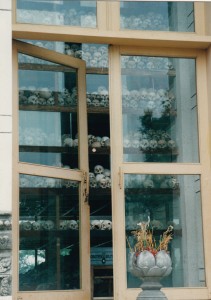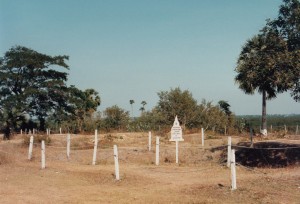[In January 2003 I accompanied an expedition that was conducting a survey of river dolphins on a stretch of the Mekong River in Cambodia. The expedition was led by Isabel Beasley, who was then a PhD student specializing on Orcaella brevirostris: also known as the ‘Irrawaddy Dolphin’ this species is found in many Asian river systems and deltas. The journal I kept during the expedition will appear on this site as a continuous series of posts. This is part 29 of the series.]
Yesterday the ‘Pol Pot times’ burst upon us unexpectedly. We were in a taxi, driving to Sambok when Mr Seng Kim said, suddenly, that compared to his children’s lives, his own childhood had been so different. His entire family was sent to a camp in Kompong Thom province. His father died and his mother had to keep the family going somehow. ‘Very hard – ver-ry dif-fi-cult.’

Mr. Somany began to laugh uproariously at this and said: ‘Did your mother marry again?’ I had the impression that this exchange was founded on the usual Cambodian unease about the ‘Pol-Pot-time’ – any mention of which seems to occasion uproarious laughter. I thought that he himself was perhaps too young to have experienced the Pol-Pot-time and just wanted to put an end to the older man’s reminiscing. But today, at the place where we’d stopped for lunch, he suddenly exclaimed: ‘It was not just him (Mr. Seng Kim). It was all of us – all of us went through it.’
‘You too?’ I said in surprise. ‘Yes!’ he said vehemently. Somany was 6 when Pol Pot came to power. His father died in 1975. They were taken from Phnom Penh to Takeo province – his mother and his four siblings. Once they were in Takeo Province, they were split up, all five of them. Each of them was sent to a different camp. This was in keeping with Pol Pot’s efforts to dissolve the family unit. Somany was sent to a camp for children of his age. As ‘New People’ they were taught how to pay their respects to the ‘Old People’. He saw sick children being abandoned to die. The soldiers wouuld go through the camp and say (about the sick children): ‘Let them be – maybe they’ll die tonight.’ And when they woke up next morning, sure enough, those children were dead. He would be allowed to see his mother only once every month or so. Sometimes she would bring him a sweet potato. Every time he saw her, all she could do was cry and cry. Sometimes he would run run away from his camp to try and find her.
In 1979 he and all the others at the camp heard the sound of bombs and shooting. They heard that the Vietnamese were coming in tanks. He didn’t know what a tank was and he was desperately keen to find out. He ran out on to the road and waited for the tanks. When they came by, the Vietnamese soldiers were standing in the turrets, waving.
[Memorial, ‘Killing Field’ near Phnom Penh, 1993]
After that he managed to find his mother and somehow, miraculously, all the other siblings managed to find her as well. They started walking toward Phnom Penh – ‘it was very, very difficult’ – he couldn’t find words and almost had to stop talking. He pointed to the sandals on his feet and said ‘we had none of these; just had to walk.’ After that he changed the subject and began to talk about the dolphins and the survey work, which he clearly loves and performs with great enthusiasm.


